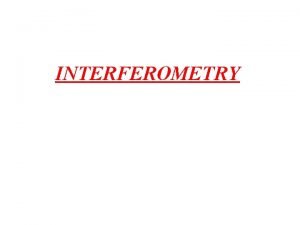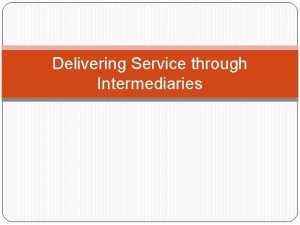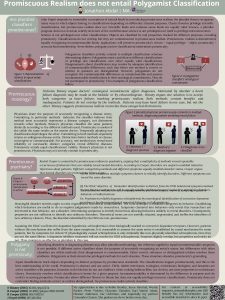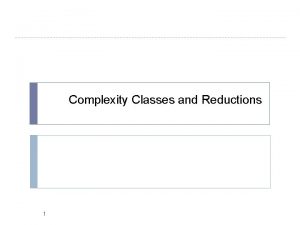Delivering NPL reductions What does it entail Prof















- Slides: 15

Delivering NPL reductions: What does it entail? Prof. Louka T. Katseli Chair, National Bank of Greece, Cyprus EUROPEAN INVESTMENT SUMMIT OCTOBER 11 -12, 2017 ROYAL OLYMPIC HOTEL, ATHENS 1

I. Opportunities and Risks Opportunities: Within global market, there is a window of opportunity for Greece and Cyprus to reduce their NPEs, clean their balance sheets and support economic recovery. Why? ü ü ü Targets have been set for NPL reduction Legal framework and judicial processes improved Investor interest is significant Strong interest by international Loan Management Companies (LMCs) and Loan Transfer Companies (LTC) Mounting pressures on banks by regulators to deliver Digital platforms can cater to customer needs, lower transaction costs and enhance transparency 2

I. Opportunities and Risks (cont) Risks: Risks however have not disappeared: ü ü ü Anemic growth will continue to create NPEs by households and firms (Recent market survey: 67% of Greeks estimate that their living conditions will deteriorate over the next 12 months). Distributional effects matter: acceleration of growth rates does not guarantee improved capacity to pay. Implementation of legal and institutional reforms, including e-auctions could be delayed. Banks could continue to move slowly and cautiously. Investor appetite might stall and could be lured into more profitable markets. To deliver results existing impediments need to be addressed effectively… 3

II. Impediments to be addressed… 1. 2. 3. 4. 5. Multiple stakeholders with non-aligned interests in need of coordination Market failures, especially information gaps and asymmetries Restructuring of corporate loans often requires enhanced but missing capacities Successful implementation requires partnerships, effective monitoring, evaluation and corrective actions External finance often needed to bridge gap between bid and ask price or inject equity capital into companies under restructuring Addressing impediments effectively requires a systemic and strategic approach for NPE management that provides proper incentives, improves capacities and strengthens institutions. 4

II. Impediments to be addressed… (cont) 1. Multiple stakeholders with non-aligned interests in need of coordination Interest to: ü Safeguard capital adequacy ü Meet regulators’ requirements ü Enhance profitability and co-share potential future benefits from NPE management Interest to: ü Enhance financial stability ü Reduce macro and micro prudential risks Banks Regulators & Oversight Bodies (SSM, Central Bank, HFSF, ESM, Troika) The NPE Market Interest to: ü Restructure loans ü Protect assets, esp. productive ones Borrowers ü Maintain capacity to (Firms & cover needs & obligations Households) & to keep up productive activities Government Interest to: ü Maximize profits üMinimize risks & delays Investors & Loan Management & Loan Transfer Companies ü Channel liquidity into economy üRestructure viable companies to enhance growth and employment ü Reduce macro and micro prudential risks 5

II. Impediments to be addressed… (cont) 2. Market failures, especially information gaps and asymmetries ü ü ü Risk Committees and Boards have information on bank-specific microprudential risk but make rough estimates of macro-prudential risk, growth and employment prospects and future policy stance, which would affect NPE market. Banks have information on large corporate NPE portfolios but very limited information on SME NPE portfolios. LMCs and LTCs enter competitive market (already 8 licensed companies – 10 in the pipeline) with limited knowledge of the potential size of the market, the bank’s appetite to transfer portfolios or the expected net profitability of their investment. Investors do not know what is “hidden in the closet” when corporate loans are transferred or require injection of capital. Regulators question information provided by banks and push for recurrent AQRs and stress-tests. Firms and households have no full information on products offered by banks and expected gains or loss from restructuring options; preference for “wait and see” especially when value of loan is greater than value of asset. 6

II. Impediments to be addressed… (cont) 2. Market failures, especially information gaps and asymmetries (cont) ü Banks adopt conservative stance, prefer to take previsions and transfer only legacy portfolios or portfolios from which they have little to gain. ü LMCs & LTCs enter market aggressively but can become quickly disappointed and pressure regulators. ü Regulators tighten targets, enhance operational supervision. ü Government legislates and tries to mediate conflicting interests across different stakeholders. 7

II. Impediments to be addressed… (cont) 3. Restructuring of corporate loans often requires enhanced but missing capacities ü Special asset units for NPE management have limited capacity to deal with NPE portfolio. ü Asset evaluation & management units within banks not properly integrated with NPE management units; procedures for asset evaluation are not sufficiently objective and transparent. ü Banks devote large amount of resources to managing large corporate nonperforming portfolios and negotiate across systemic banks; there is limited capacity to deal with SME portfolio. ü Skills and experience missing to restructure companies as opposed to loans. ü LMCs do not provide integrated services for restructuring of companies backed by external financing. Limited capacities enhance inertia 8

II. Impediments to be addressed… (cont) 4. Successful implementation requires partnerships, effective monitoring, evaluation and corrective actions ü Banks have not yet articulated coherent strategies; Information gap discourages partnerships. ü Given multiple stakeholders with non-aligned interests, effective implementation requires not only ex-post monitoring of outcomes (targets) but independent monitoring and evaluation of banks’ internal processes. ü Quality and costs of existing reporting process and regulation also in need of independent evaluation. ü Self evaluation by banks and regulators has its limits; so has complete decentralization of decision making. Proper incentives and an effective governance mechanism or structure are needed to monitor, evaluate and improve outcomes 9

II. Impediments to be addressed… (cont) 5. External finance often needed to bridge gap between bid and ask price or inject equity capital into companies under restructuring ü ü Gap between bid and ask price can be closed if finance is available. Under present conditions, domestic banks have limited capacity to promote financing for restructuring. External finance can be available if information failures are overcome and process completely secure and transparent. Availability of external finance can play a catalytic role in overcoming inertia. 10

III. Designing proper “nudges”: some proposals ü Adoption of a systemic approach to NPE management is needed involving all stakeholders. ü Enhanced dialogue and information sharing across stakeholders is essential. ü The Special Secretariat for Private Debt Management could assume a convening and coordinating role. 11

III. Designing proper “nudges”: some proposals (cont) Banks could: ü Segment loan portfolios by sector and sub-portfolios according to various criteria (large corporate, SMEs, households / risk-return factors / size / legacy vs recent loans etc. , clustering of customers according to viability & willingness to pay etc. ) ü Develop and articulate a medium-term strategy for NPE reduction by sub-portfolio and provide a clear and credible implementation roadmap and workflows. ü Improve coordination among banks for large corporate NPEs and develop shared viability assessments, business and restructuring plans. ü Transfer liabilities to an SPV which will own the assets and on which investors can invest; engage investors and companies in tripartite agreements which will provide for the terms of cooperation. Investors can contribute the necessary financing for the asset to produce value and profit while business agreements between investors, companies and bank can determine shares of profit and potential repurchasing of assets. ü Adopt a pro-active stance for external financing. ü Transfer loans to asset management companies or to LTCs in a transparent manner. ü Invest in internal human resource skills and capacities. ü Upgrade asset management units and improve synergies with Special Asset Units. 12

III. Designing proper “nudges”: some proposals (cont) Government could: ü Reduce macro-prudential risk by concluding third evaluation by December 2017 and current program by August 2018. ü Enhance convening, monitoring and coordinating functions of Special Secretariat for Private Debt Management. ü Mobilize IFIs (EIF, EBRD, IFC) to provide guarantees and equity to a “Special Restructuring Fund” ; participate with structural fund injection. ü Enhance capacity of legal system to expedite litigation and improve enforcement. ü Improve and invest in electronic platform for e-auctions. ü Support and invest in financial platforms for SME or household NPE loan restructuring, in collaboration with specialized private providers (PPP structure) and/or IFIs. ü Legislate, if needed, incentives (eg tax incentives) and procedures to facilitate agreements by banks, owners and investors. ü Mobilize new investors (eg pension funds). 13

III. Designing proper “nudges”: some proposals (cont) LMCs could: ü Provide more integrated portfolio management services to clients including strategic and segmentation guidance, IT infrastructure, assignment and training, specialized services, operational restructuring services, restructuring of companies, access to external finance. ü Engage in collaborative schemes with investors, collecting companies etc. Regulators & Oversight Bodies could: ü ü Delineate better oversight responsibilities and roles among themselves. Harmonize reporting requirements. Abstain from micro-management and unnecessary intrusion. Lower regulatory uncertainty and costs. 14

III. Designing proper “nudges”: some proposals (cont) Borrowers could: ü ü ü Obtain credible information and evaluate restructuring options. Cooperate with banks to seek realistic solutions. Use available legal instruments and platforms. NPE Reductions might require some… “libertarian paternalism”… Richard H. Thaler Nobel Laureate for Economics, 2017 15
 Firms react to unplanned inventory reductions by
Firms react to unplanned inventory reductions by Building an organization capable of good strategy execution
Building an organization capable of good strategy execution Npl flatness interferometer light source
Npl flatness interferometer light source Npl certificate in educational leadership
Npl certificate in educational leadership Npl directive
Npl directive Npl netball
Npl netball Spikes setting perception invitation
Spikes setting perception invitation Where is the vanishing point
Where is the vanishing point Designing and delivering oral and online presentations
Designing and delivering oral and online presentations Delivery of services through intermediaries
Delivery of services through intermediaries Chapter 33 delivering dental care
Chapter 33 delivering dental care Exclusive distribution channel
Exclusive distribution channel Manuscript for speech
Manuscript for speech What is entertainment speech
What is entertainment speech Nine key strategic steps to produce defect free software
Nine key strategic steps to produce defect free software Delivering business value with it at hefty hardware
Delivering business value with it at hefty hardware





























